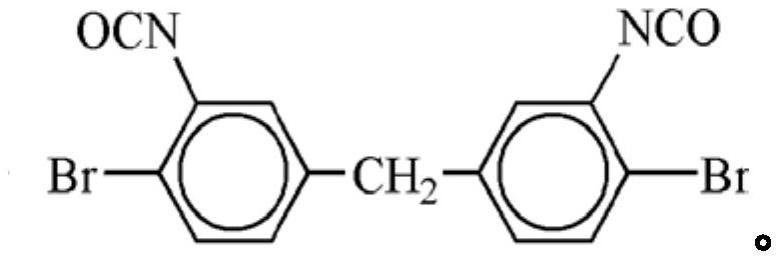Flame-retardant diphenylmethane diisocyanate derivative and synthetic method thereof
A technology of diisocyanate and diphenylmethane, which is applied in the field of polyurethane materials, can solve the problems of poor flame retardancy of polyurethane foam materials, achieve the effects of improving flame retardancy and VOC performance, high flame retardancy upper limit, and reducing usage
- Summary
- Abstract
- Description
- Claims
- Application Information
AI Technical Summary
Problems solved by technology
Method used
Image
Examples
Embodiment 1
[0042] The structural formula of the flame-retardant diphenylmethane diisocyanate derivative of the present embodiment is:
[0043]
[0044] The synthetic method of the flame-retardant diphenylmethane diisocyanate derivative of the present embodiment is as follows:
[0045] Bromoaniline-containing monomer small molecule raw material, the structural formula is as follows:
[0046]
[0047] First, small molecules containing bromoaniline monomers react with 25% to 35% hydrochloric acid catalyst (the molar ratio of hydrochloric acid to small molecules of aniline monomers is 0.5 to 1.0:1) to generate aniline hydrochloride solution, and then add 35% ~39% formaldehyde aqueous solution (the molar ratio of formaldehyde and aniline monomer small molecules is 0.3~0.5:1), conduct condensation reaction at 80°C for 1~2h, then raise the temperature to about 100°C for 1h, carry out Rearrangement reaction, the solution is neutralized with caustic soda aqueous solution to become neutral ...
Embodiment 2
[0056] The flame-retardant diphenylmethane diisocyanate derivative of the present embodiment has the structural formula:
[0057]
[0058] The synthetic method of the flame-retardant diphenylmethane diisocyanate derivative of the present embodiment is as follows:
[0059] Bromoaniline-containing monomer small molecule raw material, the structural formula is;
[0060]
[0061]First, small molecules containing bromoaniline monomers react with 25% to 35% hydrochloric acid catalyst (the molar ratio of hydrochloric acid to small molecules of aniline monomers is 0.5 to 1.0:1) to generate aniline hydrochloride solution, and then add 35% ~39% formaldehyde aqueous solution (the molar ratio of formaldehyde and aniline monomer small molecules is 0.3~0.5:1), conduct condensation reaction at 80°C for 1~2h, then raise the temperature to about 100°C for 1h, carry out Rearrangement reaction, the solution is neutralized with caustic soda aqueous solution to become neutral to obtain a fl...
Embodiment 3
[0070] The flame-retardant diphenylmethane diisocyanate derivative of the present embodiment has the chemical structural formula:
[0071]
[0072] The synthetic method of the flame-retardant diphenylmethane diisocyanate derivative of the present embodiment comprises the following steps:
[0073] Bromoaniline-containing monomer small molecule raw material, the chemical structure formula is:
[0074]
[0075] First, small molecules containing bromoaniline monomers react with 25% to 35% hydrochloric acid catalyst (the molar ratio of hydrochloric acid to small molecules of aniline monomers is 0.5 to 1.0:1) to generate aniline hydrochloride solution, and then add 35% ~39% formaldehyde aqueous solution (the molar ratio of formaldehyde and aniline monomer small molecules is 0.3~0.5:1), conduct condensation reaction at 80°C for 1~2h, then raise the temperature to about 100°C for 1h, carry out Rearrangement reaction, the solution is neutralized with caustic soda aqueous solutio...
PUM
 Login to View More
Login to View More Abstract
Description
Claims
Application Information
 Login to View More
Login to View More - R&D
- Intellectual Property
- Life Sciences
- Materials
- Tech Scout
- Unparalleled Data Quality
- Higher Quality Content
- 60% Fewer Hallucinations
Browse by: Latest US Patents, China's latest patents, Technical Efficacy Thesaurus, Application Domain, Technology Topic, Popular Technical Reports.
© 2025 PatSnap. All rights reserved.Legal|Privacy policy|Modern Slavery Act Transparency Statement|Sitemap|About US| Contact US: help@patsnap.com



